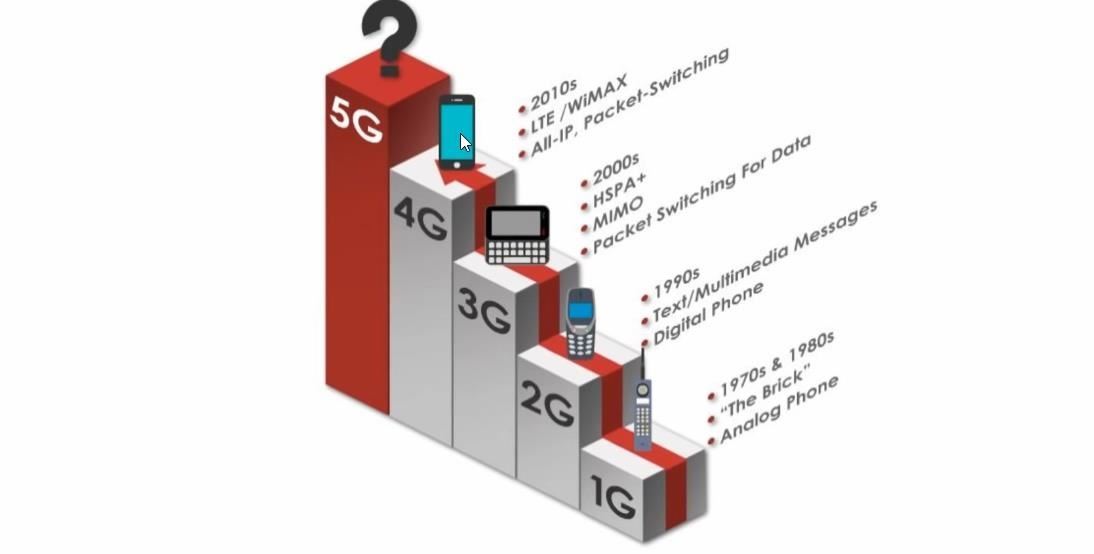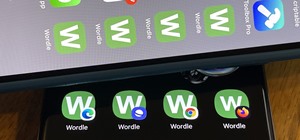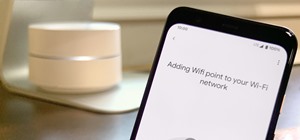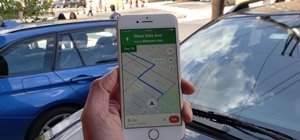We are now in the age of 5G. Carriers worldwide are upgrading their networks to the newest standard for mobile, which will dramatically improve your phone experience. How? By giving it download speeds and latency that surpass Wi-Fi. But before you upgrade, there are few things you should know first.
With 5G, your mobile devices will now have access to gigabit internet speeds. With downloads now blazing fast on mobile, new possibilities are opened up for inventions. Autonomous cars, more IoT devices, and smart cities are just some of the things in the works, with many more that haven't been imagined yet.
So all you have to do is pick up a 5G phone? Not quite. There are a lot of new technologies in the wireless network upgrade that you should know. These are terms you'll hear tossed around at your carrier store the next time you're in for an new phone, and knowing them will help you avoid getting duped by things like fake 5G.
What Does '5G' Mean?
5G is the fifth generation technology standard for mobile networks. As with 4G and previous generations, 5G brings faster download and upload speeds, and new technology will emerge thanks to the low latency and faster speeds of 5G. This could range from advancements in autonomous cars to entire smart cities.

Who Created 5G?
The 5G standard was developed by 3GPP (3rd Generation Partnership Project). This is the umbrella organization responsible for creating the protocols which compromise all the mobile technology standards, including 3G and 4G.
As part of 5G, a new radio access technology known as New Radio (NR) was created. It is with this radio that devices can receive true 5G signals.
Why Are Radio Frequencies Such a Big Deal with 5G?
Because of Wi-Fi, prior mobile standards, and other wireless signals, 5G needs an extensive list of frequencies to not interfere with other signals while still delivering faster speed. As a result, NR's bands operate within two categories, Frequency Range 1 (FR1) and Frequency Range 2 (FR2).
FR1 are signals between 410 MHz and 7.1 GHz. Although it can technically run higher, this range is colloquially called "sub-6 GHz," as most of the frequencies are less than 6 GHz. 5G also brings a new range of spectrum to mobile devices, known as mmWave, which operates between 24–100 GHz, although most phones will use frequencies between 25–39 GHz.

What's Low-Band 5G?
Frequencies in the sub-6 GHz range further categorized into two groups: low bands and mid-bands. Low bands are signals broadcast on a frequency less than 1 GHz. They can travel very far distances, covering many miles with a signal tower.
Unlike higher frequencies, low-band 5G signals aren't absorbed by walls and buildings, making them the best for extensive coverage. However, with lower frequency comes less bandwidth, which means data speeds are much slower than other 5G signals. Typical speeds range from 30–250 Mbps with low-band.
What's Mid-Band 5G?
Mid bands are the Goldilocks range. Signals in this frequency range are between 1–7.125 GHz. Towers using this frequency can provide service up to several miles away. And thanks to the higher frequency, bandwidth is higher, allowing devices to achieve download speeds between 100–900 Mbps, nearly 27 times faster than 4G.
However, it isn't without weakness. Namely, there isn't much space left in this range. With GPS, satellites, Wi-Fi, 3G, 4G, and other wireless communications already on similar frequencies, there is hardly any spectrum left for 5G to use without interfering with other signals. To help combat this, the FCC is working to open up 3.5 GHz, and 3.7–4.2 GHz for 5G, which is less crowded.

What's mmWave?
Then, there is mmWave. At frequencies above 24 GHz, these signals are capable of unprecedented speeds. We are talking 1–3 Gbps downloads. We have even seen multiple devices reach 4.3 Gbps.
But with such a high frequency comes minimal range. mmWave can only provide around 1,500 feet of coverage. Since it is unable to pass through buildings and trees (and can even be obstructed by rain), it is nearly impossible to provide coverage with a single tower. Instead, a new invention had to be created, small cells.

How Will Cellular Networks Change with 5G?
To help with limited coverage of mmWave, 5G will use a network of small cells. These are small towers positioned throughout an area that help provide coverage where a single tower couldn't reach.
Deploying these cells is expensive, so carriers are currently limiting their rollout to dense urban areas such as stadiums and convention centers. Eventually, these cells will be installed in more places, making mmWave accessible to more people.

What Else Is Upgraded in a 5G Network?
Besides the new frequency, 5G also add several new technologies to support the NR signal. While these technologies aren't new (many were introduced in LTE Advanced), they were previously optional.
Carrier aggregation allows a wireless carrier to increase the data rate for users through multiple frequency blocks (known as component carriers). These blocks can come from signals of the same or different frequencies, allowing you to maintain a high data rate even as the network gets crowded.

QAM increases the bandwidth by adding more signals to a radio wave. For example, 5G will use either 64 or 256 QAM, which indicates there are 64 or 256 possible combinations in the signal channel. The more combinations, the higher the bandwidth. Eventually, 5G will use 1,024 QAM.
MIMO, or Multiple input, multiple output, uses multiple antennas simultaneously to send data over the same radio channel, increasing the speed. Many LTE phones use 4x4 MIMO, or four receiving antennas and four transmitting. With 5G, this technology evolves to massive MIMO, a system where there are more antennas than users. Towers will have over 128 antennas arrays, each having eight (or more) sending and receiving antennas. This will allow towers to handle more users.
What Is Beamforming?
With more antennas comes more chances for interference. As a result, beamforming is needed, which uses multiple antennas to adjust the direction of transmitting signals so that they don't interfere. With beamforming, signals can travel efficiently to your device instead of using a blanket signal to cover a large area.

What's Dynamic Spectrum Sharing?
DSS, or Dynamic Spectrum Sharing, is another emerging technology to assist with 5G. Because wireless carriers have limited spectrum in the sub-6 GHz range, this technology was created to share the space efficiently.
For example, without DSS, if a carrier had 40 MHz of a 2.5 GHz network, they might give 30 MHz to their 5G network and 10 MHz to their 4G. With DSS, no division is needed, as the spectrum is adjusted automatically based on user demand.
How About NSA Mode & Enhanced Mobile Broadband?
With upgrading to a 5G network being a huge endeavor for any wireless carrier, 3GPP developed the NSA, or Non-standalone mode. Systems in this mode continue to uses 4G Evolved Packet Core (EPC) with their 5G NR software.
EPC is the framework that unifies voice and data on the LTE network. With this deployment, carriers can provide eMBB ( Enhanced Mobile Broadband), higher capacity, and faster speeds without low latency.
If There's Non-Standalone Mode, Is There Standalone Mode?
In June 2020, 3GPP will publish Release 16, which includes the SA, or Standalone mode. SA networks will use a 5G Packet Core to handle all voice and data.
This means the entire connection is 5G, allowing for uRLLC (Ultra-Reliable Low Latency Communications) and mMTC (Massive Machine Type "Communications). The latter is the ability to connect to many devices that require low bandwidth and power. In addition, EPC will be used for 4G networks after a future upgrade.
How Do I Use 5G Today?
To use the latest standard, you need two things: a phone with a 5G modem and a network with 5G turned on.
As in the early days of 5G, how well your phone operates will depend on how long you've waited. For early adopters, 5G is a bit of a mess. The modem consumes a ton of battery. Since most networks activated their mmWave signals much later in their 5G rollout, many older phones don't include support for these radios. So you can get 5G if you want it, but you might not actually want it right now.

Which Phones Support 5G?
Besides mmWave, newer 5G phones support new sub-6 GHz bands as they are turned on. The FCC is making a large amount of 3.5 and 3.7–4.2 GHz spectrum available to carriers. The FCC also has auctioned spectrum in the mmWave range to help bolster the capacity of these signals.
Where Are the Best 5G Networks?
As far as networks go, unless you are on an MVNO, you already have access to 5G, although in a limited fashion. Expect only low- and mid-band 5G outside of extremely dense areas for now. If you're deciding whether you want to use 5G, check out our guide for each carrier's current availability.
Just updated your iPhone? You'll find new features for Podcasts, News, Books, and TV, as well as important security improvements and fresh wallpapers. Find out what's new and changed on your iPhone with the iOS 17.5 update.






















Be the First to Comment
Share Your Thoughts